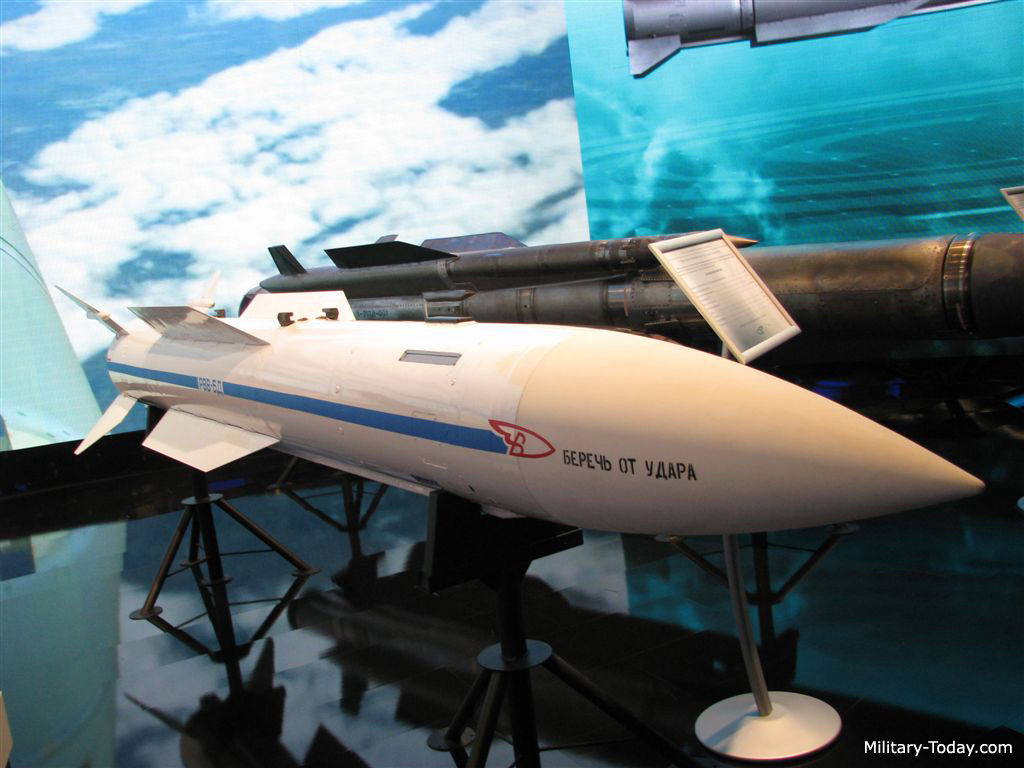Zarvan
ELITE MEMBER

- Joined
- Apr 28, 2011
- Messages
- 54,470
- Reaction score
- 87
- Country
- Location

The R-37 was a Russian answer to the US AIM-54 Phoenix
R-37M RVV-BD
Country of origin Russia
Entered service 2016 (?)
Missile
Missile length 4.06 m
Missile diameter 0.38 m
Fin span 1.02 m
Missile launch weight 510 kg
Warhead weight 60 kg
Warhead type Conventional
Range of fire up to 200 km
Guidance semi-active and active radar homing
The R-37 (Western designation: AA-13 Arrow, although sometimes AA-X-13 Arrow) is a large, fast, powerful, and extremely long-ranged Russian air-to-air missile. Vympel, a sizeable research and production company, (now part of TRV) designed and built the R-37.
The R-37 was developed to replace the R-33 (Western designation: AA-9 Amos), which was used on the MiG-31. Its main purpose is to shoot down aircraft (particularly high value AWACS—Airborne Warning And Control System—aircraft) and possibly even cruise missiles from such long range that the launch platform is safe from retaliation.
A council of ministers in the USSR started the development of the R-37 in 1983. Testing began six years later in 1989. In 1994, the K-37 (the R-37’s name in development) secured a kill and a record at the same time by hitting its target from 300 kilometers. However, in 1998, the K-37 program was dropped due to its high cost and lack of enough suitable MiG-31 launch platforms. But, in 2006, the Russian government restarted the weapon’s development as part of the MiG-31BM program. The new version is known as R-37M or RVV-BD. It is unknown if this missile has entered service yet, although according to some sources it entered production in 2014.
The R-37M is believed to track its targets with both semi-active and active radar homing. Its radar system is the 9B-1388. The R-37M probably homes on its targets in this way: first, the launch platform detects its target and launches the R-37 towards the target’s hypothesized position. Once the R-37M comes within suitable range of the target, it activates its own radar and homes in on the target. The R-37M can also use a fire-and-forget mode where it is completely independent of its launch platform.
The recent R-37M is a powerful and effective missile. It is much more maneuverable than its predecessor, the R-33. It can engage targets from any altitude between 15 and 25 000 meters, giving it great versatility. Its high explosive fragmentation warhead is huge—60 kilograms—and capable of critically damaging even large AWACS aircraft. It has an incredibly fast speed—Mach 6 or about 7 350 km/h, which is enough to easily catch up with every type of aircraft. Above all, it reportedly has an enormous range— of up to 200.
Although normally called the R-37, this missile has many other names. In the West it is designated as the AA-X-13, AA-13, Arrow, or even Andi. In Russia, it is also known as the Izdeliye 610 or RVV-BD (Raketa Vozduh-Vozduh Bolyshoy Dalnosty or English for Long-Range Air-to-Air Missile).
It appears that the R-37M will be used on two types of aircraft. The first is the MiG-31BM, an extremely fast interceptor aircraft. The second is the Su-35S, a powerful multi-role fighter.
Variants
K-37: development name.
R-37 is an original version. Its development began in 1983 and was stopped in 1998 due to funding problems. In 1994 a prototype of this missile secured a kill and a record at the same time by hitting its target from 300 kilometers. This missile was never produced in quantity.
R-37M is a significantly improved version. It is also known as the RVV-BD. Development of the R-37 was restarted in 2006 and significant changes were made to the missile. Also it uses a slightly different guidance method. The R-37 has a range of up to 200 km, depending on flight profile. Maximum range is achieved in "cruise glide" mode. According to some sources this missile is in production for the Russian armed forces.
Related Weapons
AIM-54 Phoenix: to date, the AIM-54 Phoenix is the only US long-range air-to-air missile. It entered service in 1974. With a large warhead, active radar homing, speed of Mach 5, and range of about 190 km, the Phoenix was reasonably powerful. It was only used on one type of aircraft—the F-14 Tomcat. In 2004, the Phoenix was retired from US service and the F-14’s retirement followed soon after. Iran is the only other nation besides the US to use the missile as well as the aircraft, and it continues to do so.
R-33: It is a predecessor of the R-37. It is a large, long-range air-to-air missile used on the MiG-31. It has a range of more than 120 km and uses semi-active radar homing.
K-100: like the R-37, the K-100 is intended to destroy AWACS aircraft. Also like the R-37, it was developed in the 80s until work stalled in the 90s. The K-100 remains under development, but when it enters service (if ever), it will be used by both Russian and India, with Su-27, Su-30, Su-30MKI,Su-35, and PAK FA aircraft.
R-37
Long-Range Air-to-Air Missile

R-37
Long-Range Air-to-Air Missile

R-37
Long-Range Air-to-Air Missile

R-37
Long-Range Air-to-Air Missile

R-37
Long-Range Air-to-Air Missile

R-37
Long-Range Air-to-Air Missile

R-37
Long-Range Air-to-Air Missile

http://www.military-today.com/missiles/r37.htm
